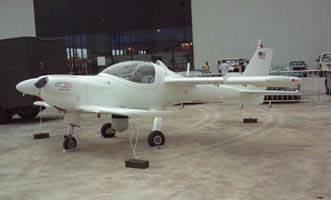 |
|||||
Main>Articles>Military Stuff>Eagle ARV
Eagle ARV

The Eagle ARV is an
UAV (unmanned aerial vehicle) jointly developed by CTRM Sdn. Bhd. and
BAe Systems. The Eagle 150 sports and recreational light aircraft was
modified so that it could be piloted via a secure radio link. However,
the Eagle ARV is unique among UAVs in that it retains the capability to
be flown by a pilot. Also, a WESCAM rotating turret housing three cameras
was fitted to the underside of the aircraft to enable it to conduct intelligence
gathering and surveillance missions.
Fully constructed from composite materials, the
Eagle ARV is powered by a Teledyne Continental 10-240-B7B piston engine
producing 125hp. With a cruise speed of 125 knots, the Eagle ARV can fly
a distance of over 200km. Cruise altitude is at 13,000ft and an endurance
of 10 hours can be achieved. It maintains contact with a GCS (Ground Control
Station), which is mounted on a track chasis. A direct line-of-sight link
can be maintained at ranges of up to 200km. However, the UAV can fly even
further if loaded with a pre-programmed flight plan. In the GCS, there
are two stations; one for the pilot to control the UAV, and another for
the payload operator. IT contains a Data Exploitation and Mission Planning
System that can receive up to 256 waypoints for the UAV to follow autonomously.
All data is recorded into two VHS recorders.
Apart from the GCS, the Eagle UAV can relay data directly to forward-deployed
troops if they carry small parabolic receiver dish known as the RRS (Remote
Receiving Station). This is important since commanders in the field frequently
require intelligence imagery in real-time and cannot afford to wait for
it to be processed by the GCS before being relayed to them. In this mode,
the UAV can transmit data to RRS stations up to 30km away.
The WESCAM FLIR-pod has space for 4 sensors, however,
the RMAF has so far fitted only 3 cameras into the system. Firstly, a
Sony XC-999 CCD TV camera is carried. It comprises of two cameras; first
a spotter scope (which has a wide field-of-view), as well as another camera
with zoom capability. Secondly, a Indium Antimonide thermal imaging camera
with a zoom of up to 5 times is mounted to allow the UAV to take intelligence
imagery at night and in poor weather. The turret can rotate a full 360-degrees
and is fully stabilized.
As of July 2002, the RMAF has received a single Eagle ARV (Airborne Reconnaisance
Vehicle) system, comprising of 3 Eagle UAV aircraft, GCS and RRS stations.
It is expected that after operational evaluations are complement, more
Eagle ARVs will be inducted into service. The UAV's role in the RMAF is
to gather inteligence imagery in hostile territory, provide artillery
spotting, maritime surveillance, assist the police in airborne patrols
and many others.